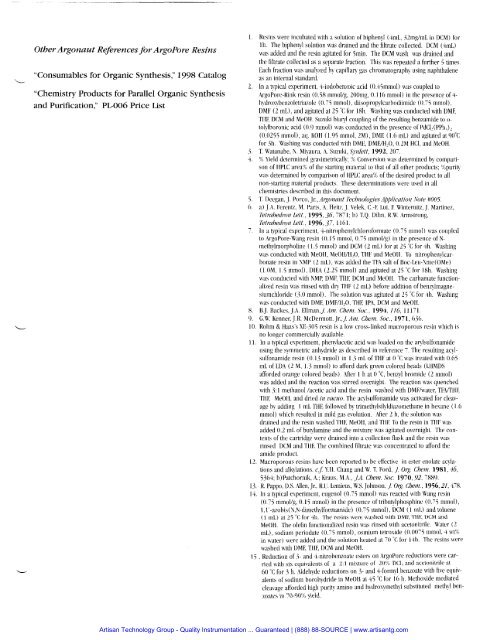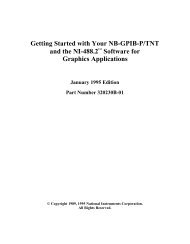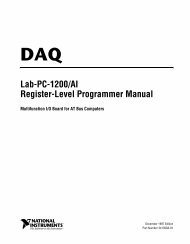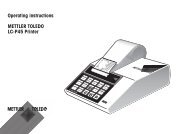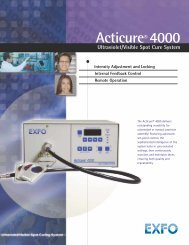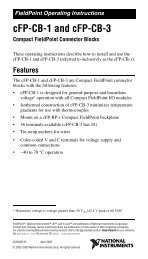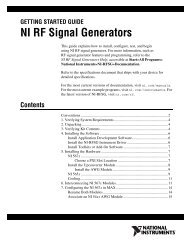Argonaut Quest Training Workshop 2 (pdf) - Artisan Scientific
Argonaut Quest Training Workshop 2 (pdf) - Artisan Scientific
Argonaut Quest Training Workshop 2 (pdf) - Artisan Scientific
You also want an ePaper? Increase the reach of your titles
YUMPU automatically turns print PDFs into web optimized ePapers that Google loves.
LOther <strong>Argonaut</strong> References for ArgoPore Resins"Consumables for Organic Synthesis," 1998 Catalog"Chemistry Products for Parallel Organic Synthesisand Purification," PL-006 Price List1. Resins were incubated with a solution of biphenyl (mL, 32mF/mL in DCM) forIh. The biphenyl solution was drained and the filtrate collected. DCM (41111)\\as added and the resin agitated for imin. The DCM wash was drained andthe filtrate collected as a separate fraction. This was repeated a fnrther 5 times.Each fraction was analyzed bp capillan gas chromatography using naphthaleneas an internal svandard.2. 111 a typical experiment. Y-iodobenzoic acid (0.4irnmol) was coupled toi\rgoPore-Kink resin (0.58 nimoVg, LOOrng, 0.1 16 mmol) in the presence of 4-li?drox~l~enzoletri:noIe (0.3 mmol), diisopropylcarhodiimide (0.-5 mmol).DMF (2 mL), and agitated at 25 "C for 1% Wiashing IW.S conducted with DMETIIF, DCM and MrOH. Snmki hiql coupling of the resulting bcnzamide to o-tolylhoronic acid (0.9 mmol) was conducted in the presence of I'dCI,(PPhJ2(0.0255 mmol), aq. KOH (1.95 mmol, 2M), DME (1.6 mL) and agitated at 90°Cfor 3h. kshing was conducted with DMI, DMFJH,O. 0.2M HCI, and MeOH.T. Rvanabe, h. Miyaura, A. Suzuki. .Sj~zbtt. 1992. LO'.X Yield determined gra\irnetric;dl!-; % Conversion \\as deternlined h) comparisonof 1IPI.C area%, of the svarting material to that of all other products; 'purity\\.as determined hp comparison of IIPLC area% of the desired product to allnon-starting material products. These determinations \\ere used in allchemistries described in this document.T. Deegan, J. Porco, Jr.,Arfionaut Techrzol~~gies;l~p/icatio~t .\htt?#005.a) J.A. Fcrentz, M. Paris, A. Heit7, J. Velek. C.-E Lui. F. U'internitz, J. Martinez.Tetrc!hedron Lett., 1995,36, 78-1; h) T.Q. Dilin, K.W. Armstrong,TWmhedron Lett.. 1996,37, 1161.In a hpical experiment. 4-nitrophenylchlorofor~i~ate (0,'s mmol) \!as coupledto ArgoPore-Wang resin (0.15 mmol. 0.-5 mmol/g) in the presence of N-meth!-lmorpholinc (1.5 mmol) and 1)CM (2 mL) for at 25 "C for rh. Washingwas conducted with MeOIl. MeOWHJ), THF and MeOIl. To nitrophenylcarhonateresin in SMP (2 niL), was added the TFA ralt of Boc-Leu-Snle(OMe)(1.OM. I .5 mmol), DlEA (2.25 mmol) and agitated at 25 T for 1811. Washing\\.as conducted with KMI', DMF, THE DCM and MeOH. The carbamate functionalizetlresin ws rinsed with dl? THF (2 mL) hefore addition of bennlmagne-siumchloride (3.0 mmol). The solution ms agitated at 25 T for ~ h Washing .was conducted \vith DMF, DMF/H?O, TMF, IPA. DCM and MeOH.B.J. Rackes. J.A. E1lman.J dm. Cheni. Jbc., 1994. 116, 111'1.G.W Kenner. 1.R. McDermott. . Jr.,./. . Am. C1)ent. .Sot.. 1971, h3(1.10. Rohm & Haas's XE-305 resin is a low cross-linked niacroporous resin which isno longer commerciallv available.11. In a t!;ical experimen;, phenylacetic acid has loaded on the arylsulfonaniidensing the symmetric anh!dride as described in reference '. The resulting acplsulfonamideresin (0.13 mniol) in 1.3 ml. of THF at 0 "C \\.as treated with 0.65rnL of LDA (2 M. 1.3 mmol) to afford dark green colored heads (LIIMDSafforded orange colored heads). .2fter 1 h at 0 'C. benzyl bromide (2 mmol)uas added and the reaction was stirred overnight. The rpaction ws quenchedwith 3:l methanol /acetic acid and the resin waslied with DMFhvater. TFMTHF,'I'HF, MeOH. and dried in zwctio. The acplsulfonlmiide was activated for cleav-I2j364; b)Patchornik, it.: Kraus. MA., &I. Chem. Soc. 1970.92, '889.13. K. I'appo, D.S. Allen. Jr.. R.L'. Lemiew, W.S. Johnson. J 0%. Chetn., 1956,21.+'8.Ir. In a typical experiment, eugenol (0.75 mmol) was reacted xith Wang resin(0.75 mrnol/g, 0.15 mmol) in the presence of tribut!lphosphine (0.75 mmol),15age hy adding 1 ml. THF, followed by trimethylsilyldizizo1i1etI~a1ie in hesane (1.6mmol) which resulted in mild gas evolution. After 2 11, the solution wasdrained and the resin nashed THE MeOH. and TIIF To the resin in TIlF wasadded 0.2 mI. of butylaniine and the mixturc was agitated overnight. The contentsof the cartridge were drained into a collection flask and the resin wasrinsed DCM and THE The comhined filtrate nas concentrated to afford themide product.Macroporous resins have been reported to he effective in ester enolate acylationsand alkylations. cf: Y.11. Chang and W. T. Ford, .I. 01;s. Chent. 1981, 46,1.1'-x~obis(N,N-dimetlglfor~~a~nide) (0.75 mmol), DCM (1 ml.) and tolnene(1 mL) at 25 "C for 41. The resin?, \\.ere \xwhed with 1)MF. THF, IICM andMeOH. The olefin functiondized resin \\.as rinsed with acetonitrile. Water (2mL), sodium periodate (O.'j mmol), osmium tetroaide (0.00'5 mmol. 4 wl%in wter) were added and the solution heated at 7O Y; for 1-h. The resins werewashed with DMF. TIIF, IXM and MeOH.Reduction of 3- and 4-nitrohenzoate esters on Argol'ore reductions were car-ried \\.it11 six equivalents ol a L: 1 mixture of LO'): TiCl; and acetonitrile at60 "C for 3 h. i\ldehy& reductions on 3- and 4-formyl benzoate sith file equivdentsof sodium boroh!dride in MeOH at 4 j 'C for I h 11. Methoxide mediatedcleavage afforded high purity amino and hydrosymeth~l substituted methyl henzoatesin 7O-9O'% vield.<strong>Artisan</strong> Technology Group - Quality Instrumentation ... Guaranteed | (888) 88-SOURCE | www.artisantg.com


